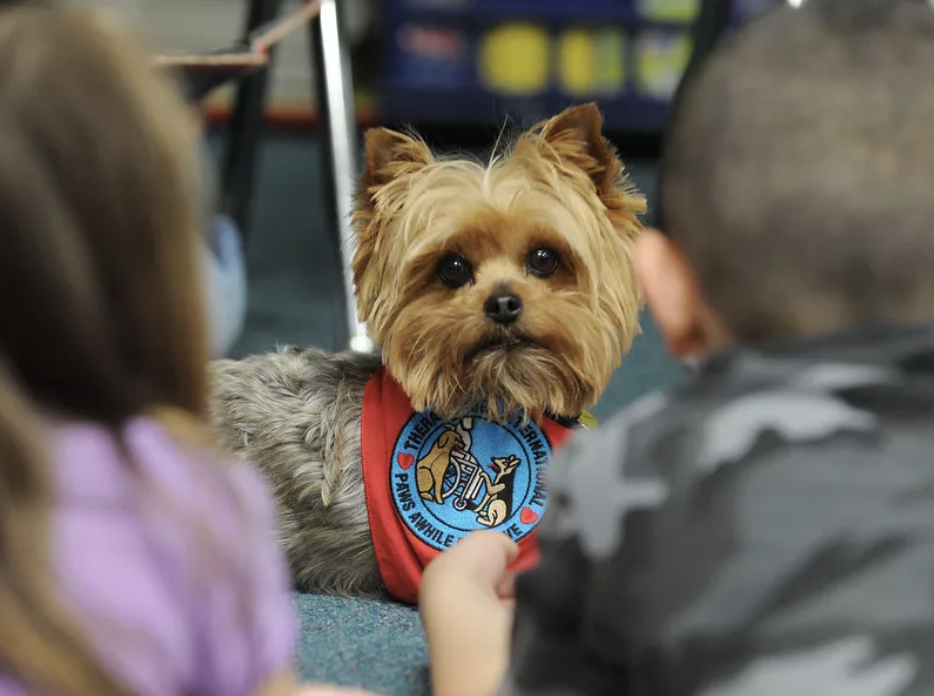
Q: Why don’t fish do well on school tests?
A: Because they work below C-Level.
Do you have pet fish at your school? What about a pet bird? There are many reasons why animals could be at your school. Perhaps it’s an agricultural school where animal husbandry is a part of the core fundamentals of the school’s curriculum. Perhaps your school has classes where there is a class pet (one that gets taken home on weekends and holidays!). Or perhaps your school has seen the educational benefits that living and breathing visiting pets can have on its students.
Whatever the reason, there’s much research to suggest that having animals present in the learning environment can be beneficial to students, in particular, students who suffer from anxiety. According to deltasociety.com.au, animals have many scientifically proven benefits to ALL students.
- Research has found that animals are useful in the promotion of health, well-being and normal development in children
- Animals can be a way of improving quality of life as a tool for socialising, relaxation and communication
- Animals can help a child who may be experiencing anxiety and stress
- Occasional contact with animals is beneficial in providing children with the opportunity to display independence and confidence
- Children may learn to gain an awareness of pro-social behaviour in regard to treating animals appropriately
- Contact with animals provides opportunities for sensory stimulation and exercise and enables children to receive and give attention and affection
- The dog provides a non-judgmental acceptance of the student
Using Delta Society is one way that animals can regularly visit a classroom to provide these educational benefits. If you’re school is in Sydney, it might be well worth checking out.However, having animals in the classroom isn’t a viable option for all schools, or for all students. Apart from allergies to pet hair and the financial cost involved in having animals come to the school, there are also State and school policies to consider. So what is the alternative?
Believe it or not, Robotic pets are an option. “Bear” with me. A recent study in the UK has found that robotic pets are a real alternative to live pets, and they’ve come a long way since the Tamagotchi or Furbi. Robot pets now look real, make realistic sounds, and even mimic a real pets movements. In fact, the Sydney Morning Herald wrote an article in Sept 2019 about how these pets are helping people with dementia. The article goes on to say “I was a bit of a sceptic,” says Professor Wendy Moyle, program director at the Menzies Health Institute at Griffith University, Queensland. “In 2009, I looked at this pet robot and thought, ‘Oh, would it really have an effect?’ They seemed to me very expensive, and there hadn’t been a lot of research done on them. So we started doing pilot study work and the results had a lot more significance than I ever imagined. To my surprise, we found they reduced anxiety and improved people’s moods.”
It would be a fair assumption that if these pets or of benefit to dementia patients, they could benefit other members of society too, such as students. But if this option isn’t viable for your school, then you may need to go with the plush toy pet option that a lot of classes use as a reward for great behaviour. It’s an inexpensive option, the pet is easy to look after, no feeding required, and can even go on exotic holidays with you. It’s a great third best, and a great way to motivate and excite your students.
No matter which option you choose to go with, they’re all excellent ways to encourage children to collaborate and to document their time together with the class pet through a class created podcast, vlog, blog, iMovie, etc. Whole class collaboration on this project makes it a learning experience in itself, as it’s engaging, ongoing, fun and creative. And with edQuire’s AI learning analytic software to keep a watchful eye on your students online activities, it’s also safe.
Have you used animals in your classrooms? We’d love to hear more!

Recent Comments